

Scholarly Articles - Multicultural Literature for Young Adults - LibGuides at California State University, Fullerton. How Cultural Differences Influence Adolescent Development. The parents of adolescents have the main responsibility of teaching children ethics.
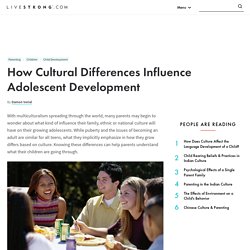
Scholars of adolescent behavior and authors of "Family and Peer Influences on Adolescent Behavior and Risk-Taking," Nancy Gonzales and Kenneth Dodge, note that while much of adolescent development happens outside the home, the culture of the family instills upon children their developmental roots. Parents coming from difference cultures emphasize different value sets and therefore teach their children different moral standards. For example, because honesty is an important concept in the West, American parents urge their children not to lie, even in situations where lying would be beneficial.
On the contrary, parents from East Asia tend to focus on creating a sense of both social and family harmony. These parents are more willing to overlook lies, provided those lies contribute to harmony, such as in white lies that avoid hurting others' feelings. Adolescent literacies in a multicultural context (eBook, 2012) Night by Elie Wiesel. I Am Malala: The Story of the Girl Who Stood Up for Education and Was Shot by the Taliban by Malala Yousafzai. A Game for Swallows: To Die, to Leave, to Return by Zeina Abirached. (Graphic Novel for Students)
The Zabime Sisters by Aristophane Boulon (Graphic Novel for Students) Yummy: The Last Days of a Southside Shorty by G. Neri (Graphic Novel for Students) Characteristics of Quality Multicultural Literature. It's not on the list: An exploration of teachers' perspectives on using multicultural literature.
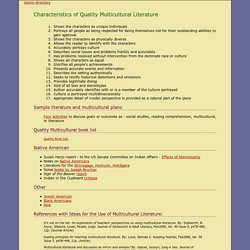
By: Stallworth, B. Joyce; Gibbons, Louel; Fauber, Leigh. Journal of Adolescent & Adult Literacy, Mar2006, Vol. 49 Issue 6, p478-489, 12p. (Journal Article) Guiding principles for teaching multicultural literature. How to Choose the Best Multicultural Books. How do you know if a children's book you're about to share with your students accurately portrays the culture of its characters?
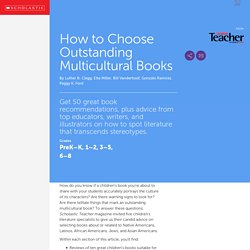
Are there warning signs to look for? Are there telltale things that mark an outstanding multicultural book? To answer these questions, Scholastic Teacher magazine invited five children's literature specialists to give us their candid advice on selecting books about or related to Native Americans, Latinos, African Americans, Jews, and Asian Americans. Multicultural Fiction for Teenagers.
The Absolutely True Diary of a Part-Time Indian by Sherman Alexie. 2007Budding cartoonist Junior leaves his troubled school on the Spokane Indian Reservation to attend an all-white farm town school where the only other Indian is the school mascot.
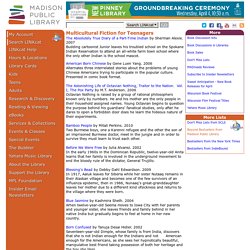
American Born Chinese by Gene Luen Yang. 2006Alternates three interrelated stories about the problems of young Chinese Americans trying to participate in the popular culture. Presented in comic book format. The Astonishing Life of Octavian Nothing, Traitor to the Nation. Vol. I, The Pox Party by M.T. Bamboo People by Mitali Perkins. 2010Two Burmese boys, one a Karenni refugee and the other the son of an imprisoned Burmese doctor, meet in the jungle and in order to survive they must learn to trust each other. Before We Were Free by Julia Alvarez. 2002In the early 1960s in the Dominican Republic, twelve-year-old Anita learns that her family is involved in the underground movement to end the bloody rule of the dictator, General Trujillo.
Culturally Responsive Teaching: 4 Misconceptions. The Effects of Multicultural Literature in the Classroom. Why Teach Multicultural Literature? iStockphoto.com I have taught literature at the college level for almost a decade and at as many as six different campuses.
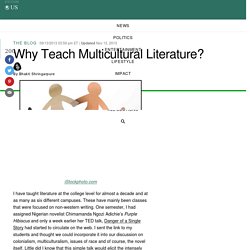
These have mainly been classes that were focused on non-western writing. One semester, I had assigned Nigerian novelist Chimamanda Ngozi Adichie’s Purple Hibiscus and only a week earlier her TED talk, Danger of a Single Story had started to circulate on the web. I sent the link to my students and thought we could incorporate it into our discussion on colonialism, multiculturalism, issues of race and of course, the novel itself.
Little did I know that this simple talk would elicit the intensely disproportionate response that landed in my inbox the next morning. Why teach U.S. students literature from different countries? Here is the video that set this off, followed by the student’s letter and my response: About the Adichie talk at the TED conference. In my opinion, Adichie perfectly typifies what you could call the ugly side of multiculturalism. My response: Multiculturalism in the Modern World: Jen Holladay at ... - Bing video. Strategies To Support Multicultural Instruction. Essential for developing multicultural/diverse perspective learnings is a positive and trusting classroom environment - one in which all students are made to feel welcome, comfortable, and respected.
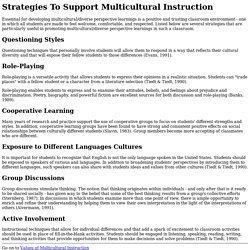
Listed below are several strategies that are particularly useful in promoting multicultural/diverse perspective learnings in such a classroom. Questioning Styles Questioning techniques that personally involve students will allow them to respond in a way that reflects their cultural diversity and that will expose their fellow students to those differences (Evans, 1991).
Role-Playing Role-playing is a versatile activity that allows students to express their opinions in a realistic situation. Role-playing enables students to express and to examine their attitudes, beliefs, and feelings about prejudice and discrimination. Cooperative Learning.